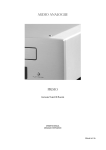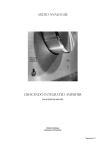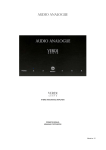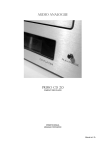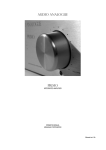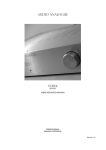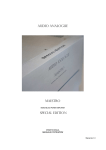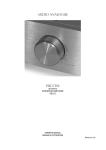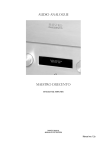Download Audio Analogue PRIMO INTEGRATED AMPLIFIER Owner`s manual
Transcript
AUDIO ANALOGUE Crescendo CD COMPACT DISC PLAYER OWNER’S MANUAL MANUALE D’ISTRUZIONI Manual rev 1.0 2 3 Dear Audiophile, Congratulations and thank you for choosing the CRESCENDO CD Player. A product which perfectly exemplifies the state of Art of the Audio Analogue CD Player: Features: Power supply: a toroidal transformer is used with secondary stages dedicated to each part: one to the analog/DAC section power supply and the others to the digital power supply. The analog power supply has been realized using all of Audio Analogue‘s strategies to reduce any interference and kill even the smallest of noise from all of its components. Regulation stages have been placed in every sensible circuit point and the bypass capacitors have been chosen not only for their electric performance but also after long and careful listening sessions. CD Mechanism: on the Crescendo CD Player, as on every Audio Analogue CD Player, the Teac CD-5010A has been mounted, a mechanism specifically designed for high end audio applications. This CD Mechanism is very sturdy and has a very low Jitter output. The best starting point for a very high performance Player! DA section: All our experience and technology here has been fully taken advantage of. We have especially focused on the power supply bypassing, the decoupling of the DAC outputs and we have worked on the layout for a perfect separation between analog and digital circuits with particular attention paid to the ground return path. Output Stage: In this product Audio Analogue has focused a lot on the output stage and a new approach to the design has been developed. We have realized a fourth order active output filter that, together with the one pole filter inside the DAC, forms a fifth order output one. Such a high order (usually found only in really very expensive products!) has permitted us to increase the cut off frequency of the output filter with very good results on the audio performance of the unit expecially for the increased precision of the listening stage. The problem of this approach is the added distortion and noise due to the number of stages the sound has to pass through but Audio Analogue has used all its experience and technology to carefully design every element of the stage choosing every passive component to reduce the overall distortion and noise with astonishing results! Caro audiofilo Congratulazioni e grazie per aver scelto il Crescendo CD Player, un prodotto che ben esprime lo stato dell’arte dei lettori CD di Audio Analogue. Caratteristiche: Alimentazione: alimentazione a trasformatore toroidale con secondari separati: uno dedicato alle alimentazioni analogiche e altri due alle alimentazioni digitali. L’alimentazione è stata implementata sfruttando tutte le strategie in possesso di Audio Analogue per ridurre qualsiasi interferenza e eliminare ovunque il rumore. Stadi di regolazione sono stati posti in tutti i punti sensibili del circuito e le capacità di bypass sono state scelte non solo per le prestazioni elettriche ma anche dopo lunghe e accurate sessioni di ascolto. Meccanica CD: Sul Crescendo CD Player, come su tutti i lettori Cd Audio Analogue è montata la TEAC CD-5010 una meccanica progettata specificatamente per applicazioni audio high end. Tale meccanica oltre ad essere molto robusta è dotata di un’uscita digitale a bassissimo jitter e costituisce attualmente il miglior punto di partenza per la realizzazione di lettori CD ad alte prestazioni. Sezione DA: si sono sfruttate tutte le tecnologie e il know how di Audio Analogue. Ci siamo concentrati in particolar modo sul bypass delle alimentazioni, sul disaccoppiamento delle uscite del DAC e si è lavorato sul layout per ottenere un’assoluta separazione tra massa analogica e digitale. Stadio di uscita: in questo prodotto Audio Analogue ha puntato moltissimo sullo stadio di uscita utilizzando un approccio di progettazione diverso da quello solitamente percorso. Abbiamo realizzato un filtro attivo del quarto ordine che insieme al filtro a singolo polo presente nel convertitore DAC va a costituire un filtro del quinto ordine. Un ordine così elevato del filtro di uscita (tale ordine si trova solitamente solo in prodotti molto costosi!) permette di aumentare la frequenza di taglio del filtro con ottimi risultati nelle prestazioni audio soprattutto per quel che riguarda la riproduzione della scena di ascolto. Il problema di questo approccio è l’aumento di distorsione e rumore dovuto al fatto che il segnale audio deve attraversare un maggior numero di stadi, ma Audio Analogue ha sfruttato tutte le proprie conoscenze e tecnologie di elaborazione del segnale al fine di ridurre la distorsione generale e il rumore ottenendo risultati sorprendenti! 4 INTRODUCTION AUDIO ANALOGUE does not take any responsibilities in the following cases: Whenever the operational procedures related to the use and the maintenance of the equipment as described in this manual are not respected. Whenever damages to the equipment occur because of fixing and modifications made form non-authorized staff or because of normal deterioration of the system. No part of this manual can be reproduced by any means, transmitted or copied for private or public use without private authorization from AUDIO ANALOGUE. The information contained in this manual is related to the data kept by AUDIO ANALOGUE at the moment of the issue o f this publication; AUDIO ANALOGUE has the right to make changes to this document without prior notice. The equipment has been projected and manufactured according to the Regulations of the Community 89/336/CEE and is marked CE. This equipment can’t be used for different purposes other than those for which it has been manufactured. AUDIO ANALOGUE does not take any responsibilities for accidents or damages due to improper use of the equipment. WARNING Please do respect the safety standards contained in this manual before starting to operate the equipment. Do not open the equipment. No further interventions than those described in this manual should be made. For technical assistance, please consult a qualified technician or an AUDIO ANALOGUE dealer. Not respecting the instructions contained in this manual will invalidate the terms and conditions of the guarantee. NECESSARY PRECAUTIONS FOR SAFETY AND MAINTENANCE ATTENTION: before starting any operation, use or maintenance of the equipment it is strictly necessary to understand the following manual. To avoid any accidents or hazards it is necessary to follow the following regulations. Activate the equipment only prior checking if the installation has been properly made, and if it is related to the instructions contained in this manual. Avoid installing the equipment in places subjected to extremely high temperatures or humidity. Check that the labels containing information about safety are always visible and in good conditions. Ensure to not obstruct ventilation, to avoid excessive overheating. The equipment should be kept to a minimal distance of 15 cm from any object and not to place on carpet or other soft surfaces. Also the installation close to radiators or in close environments without ventilation should be avoided. Do not switch on the equipment until it has not been correctly and completely installed. Only supply the equipment with the kind of the electric supply as stated on the appropriate label. If in doubts about the kind of supply available, please consult an expert technician for technical assistance. The equipment needs to be wired to an earth terminal. The external case is metal made; a defective connection with the earth may be dangerous. In case damages occurs to the supply cable, it should be immediately replaced with the same kind of cable. This operation should be only made prior to disconnecting the main supply. Do not place objects on the supply cable and check that this is not positioned in way through. The cable should not be knotted or curly. Replace the fuses always with other of the same kind. Do not use the equipment close to the water or other liquids. If liquid entered the equipment, the plug should be disconnected from the socket avoiding to touch the metal parts. Competent technical staff should be asked to check the equipment before operating it again. Do not place recipients containing liquids on the equipment. Even when it is switched off. Keep the equipment far from sources of heat such as the solar light, kitchens, radiators etc… Always unplug the supply cable during rainy weather. Always Switch off and unplug the supply cable before cleaning the equipment externally.: this operation should be made using a dry and soft cloth. Never use alcohol based cleaning material. If the amplifier was carried from an extremely cold environment to and extremely hot one, it could create internal condensation, causing possible bad functioning. If this occurs, please wait for at least an hour before using it again, to allow it to gradually reach room temperature. When not used for long periods, please unplug the equipment. INSTRUCTIONS TO PUT IT OUT OF SERVICE Consult qualified staff Follow the regulations of the current legislation regarding recycling and waste disposal. 5 PREMESSA AUDIO ANALOGUE non accetta responsabilità nei casi in cui: Le procedure operative di utilizzo e manutenzione dell’apparato descritte nel manuale non siano rispettate. I danni si verifichino in seguito a riparazioni o modifiche dell’apparato eseguite da personale non autorizzato o a seguito di normale deterioramento dell’apparato. Nessuna parte del presente manuale può essere riprodotta con alcun mezzo, trasmessa o copiata per usi pubblici e/o privati senza la previa autorizzazione di AUDIO ANALOGUE. Le informazioni contenute nel presente manuale sono relative ai dati in possesso di AUDIO ANALOGUE al momento della pubblicazione; AUDIO ANALOGUE si riserva il diritto di apportare cambiamenti al presente documento senza alcun preavviso. L’apparato è progettato e realizzato in conformità alle Direttive Comunitarie 89/336/CEE e 72/23/CEE e risulta marcato CE. L’apparato non può essere utilizzato per scopi diversi da quelli per cui è stato progettato. AUDIO ANALOGUE non si assume alcuna responsabilità per incidenti o danni causati da un utilizzo improprio dell’apparato. AVVERTENZA Prima di compiere qualunque operazione attenersi alle norme di sicurezza contenute all’interno del manuale Non aprire l’apparecchio. Nessun ulteriore intervento oltre a quelli descritti in questo manuale dovrebbe essere effettuato. Per l’assistenza tecnica, rivolgersi a un tecnico qualificato o a un rivenditore AUDIO ANALOGUE. Il mancato rispetto delle prescrizioni del seguente manuale implica il decadimento della garanzia. PRECAUZIONI PER LA SICUREZZA E MANUTENZIONE ATTENZIONE: prima dell’utilizzo o manutenzione dell’apparato o di qualsiasi operazione sullo stesso è necessario prendere visione del seguente manuale. Al fine di prevenire ogni pericolo di incidente si impongono le seguenti prescrizioni: Attivare l’apparato solo dopo aver verificato l’adeguatezza dell’installazione e la conformità alle indicazioni contenute nel presente manuale. Non installare l’apparecchiatura in luoghi soggetti a sbalzi eccessivi di temperatura e umidità. Verificare che le etichette contenenti informazioni sulla sicurezza siano sempre ben visibili ed in buono stato. Le fessure di ventilazione non devono assolutamente essere ostruite per evitare surriscaldamento dell’apparato. A tal fine, posizionare l’unità ad una distanza minima di 15 cm da ogni altro ostacolo e non su tappeti, moquette o altre superfici morbide. Evitare inoltre di installarlo nei pressi di caloriferi o in ambienti chiusi, privi di una appropriata ventilazione. Non accendere l’apparato finché non è completamente installato in maniera corretta. Alimentare l’apparato con il tipo di alimentazione elettrica riportato sull’apposita targhetta. In caso di dubbi sul tipo di alimentazione disponibile, consultare il servizio di assistenza tecnica. L’apparecchio deve essere sempre collegato a terra. Poiché l’involucro è costituito in metallo, una connessione di terra difettosa o mancante potrebbe essere pericolosa. In caso di danneggiamenti al cavo di alimentazione, provvedere immediatamente alla sostituzione con un altro dello stesso tipo. Questa operazione deve essere effettuata dopo aver disconnesso l’alimentazione primaria. Non posizionare oggetti sul cavo di alimentazione e verificare che questo non si trovi in una zona di passaggio. Il cavo non deve essere arrotolato o annodato. Sostituire i fusibili sempre con altri dello stesso tipo. Non usare l’apparato in prossimità di acqua o altri tipi di liquidi. Se nell’unità dovesse entrare del liquido, scollegare immediatamente il cavo di rete dalla presa a muro evitando di toccare le parti metalliche dell’apparecchiatura e rivolgersi al personale tecnico per un controllo prima del riutilizzo. Non appoggiare recipienti contenenti liquidi di qualsivoglia natura sopra l’apparato. Anche quando questo è spento. Tenete l’apparecchio lontano da fonti di calore come la luce solare, cucine, radiatori, etc… Scollegare sempre il cavo di alimentazione dalla presa durante i temporali. Spegnere e scollegare sempre l’alimentazione prima di effettuare la pulizia esterna dell’apparato: questa operazione deve essere effettuata utilizzando un panno asciutto e morbido. Non usare mai solventi o detergenti a base di alcool. Se l’amplificatore viene trasportato da un ambiente freddo ad un altro caldo, si potrebbe formare condensa al suo interno, causando possibili malfunzionamenti. Se ciò si dovesse verificare, si prega di attendere almeno un’ora prima dell’uso in modo da permettergli di raggiungere la temperatura ambiente gradualmente. In caso di lunghi periodi di inutilizzo, staccare la spina dalla presa di rete. ISTRUZIONI PER LA MESSA FUORI SERVIZIO Rivolgersi a personale specializzato. Seguire le prescrizioni della corrente legislazione in materia di riciclaggio e smaltimento dei rifiuti. 6 7 8 2 3 1 4 5 6 Front panel 1) Power Switch. 2) CD tray 3) STOP/OPEN. When playback is stooped, it allows Opens/closes CD tray. During playback Stops CD playback 4) PREV/REW. During playback, starts previous CD track playback, a long pressure ability Fast rewind search. When playback is stopped, it allows choosing the CD track from which resuming playback or search CD tracks backward. 5) NEXT/FFW. During playback, starts next CD track playback, a long pressure ability Fast forward search. When playback is stopped, it allows choosing the CD track from which resuming playback or search CD tracks forward. 6) PLAY/PAUSE. Starts/pauses CD playback. 7) IR receiver. 8) LCD display. Descrizione del pannello frontale 1) Interruttore di rete. 2) Cassetto porta CD. 3) STOP/OPEN. La pressione di questo tasto interrompe la lettura del disco se il lettore è in modalità play; se invece il lettore è in modalità stop, premendo il tasto si ha l’apertura o chiusura del cassetto porta CD. 4) PREV/REW. Durante la lettura del CD, la pressione di questo tasto provoca il salto immediato alla traccia precedente a quella riprodotta in quel momento. Tenendo invece il tasto premuto per qualche secondo si attiva la funzione di indietro veloce. Quando il CD è fermo (modalità stop), è possibile utilizzare questo pulsante per decidere da quale traccia iniziare la riproduzione o per scorrere in ordine decrescente le tracce presenti nel CD. 5) NEXT/FFW. Durante la lettura del CD, la pressione di questo tasto provoca il salto immediato alla traccia successiva a quella riprodotta in quel momento. Tenendo invece il tasto premuto per qualche secondo si attiva la funzione di avanti veloce. Quando il CD è fermo (modalità stop), è possibile utilizzare questo tasto per decidere da quale traccia iniziare la riproduzione o per scorrere in ordine crescente le tracce presenti nel CD. 6) PLAY/PAUSE. La pressione di questo tasto attiva la riproduzione del disco oppure ne attiva o disattiva la pausa durante la lettura. 7) Ricevitore IR. 8) LCD Display. 1 2 3 6 7 4 5 Back Panel 1) S/PDIF DIGITAL OUT: Digital output connector. 2) LEFT OUT: Unbalanced left analog output connector. 3) RIGHT OUT: Unbalanced right analog output connector. 4) Trigger OUT: See note on Trigger OUT Output. 5) Trigger IN: See note on Trigger IN Input. 6) IEC standard power inlet. Connect here the provided power cord. 7) Fuses. If necessary, replace them with others of the same kind (see back panel). Descrizione del pannello posteriore 1) S/PDIF DIGITAL OUT: Connettore di uscita digitale. 2) LEFT OUT: Connettore di uscita analogica left. 3) RIGHT OUT: Connettore di uscita analogica right. 4) Trigger OUT: vedi nota sull’uscita Trigger OUT. 5) Trigger IN: vedi nota sull’ingresso Trigger IN. 6) Presa di rete a norma IEC. Collegare il cavo di alimentazione di rete fornito in dotazione. 7) Fusibili. In caso di necessità ripristinare con fusibili dello stesso tipo (come indicato sul pannello posteriore). 7 Description of the remote controller: CD PLAYER Functions • • • • • PLAY / PAUSE STOP / OPEN PREV / REW NEXT / FFW 0123456789 (NUMERIC KEYS): According to the functioning state of the CD player you have two different actions: - when the CD player is in stop it is possible to select a track pressing the number of the correspondent song (the unit waits for PLAY to be pressed). - When the CD player is playing, pressing the number of the desired song it immediately skips to the indicated track. • STANDBY CD: it switches-on and switches-off the unit. • RPT (REPEAT) This key has different functions according to the functioning state of the CD player: When the CD player is stopped it is possible to choose to repeat a track or the entire disc by pressing the key once or twice. To choose to repeat a track you press the keys PREV and NEXT to select the track to repeat or select the track directly by its number using the numeric keys on the remote. When the CD player is playing, pressing this key in two different moments determines the initial instant (A) and final (B) of an arbitrary section to repeat. When this option is active, you can de-activate it by pressing the key again, and the normal playback of the CD is re-established. SHUFFLE function, this playing mode is enabled with the unit in STOP state and permits random playback of the tracks. While playing you can randomly change the played track with the switches NEXT and PREV on the front panel or on the remote while you can reproduce an established track using the numeric keys on the remote. • TIME/Menu: the switch has two different functions: if it is pressed while the unit is playing it activates the Time one, while if is pressed and keep pressed for about one second when the unit is in stop mode it let you enter into the setup menu. Time function: pressing the switch when the unit is playing permits to visualize different information on the reproducing time. The alternative modalities are: - the time that is left until the end of the song, modality “end of track” ( on the display it appears in “_” between the indication of the minutes and the seconds). - The time that is left until the end of the CD, modality “end of disc” (on the display it appears in “-“ between the indication of the minutes and the seconds). - The time that has gone by since the beginning of the CD, modality “total time” (on the display it appears in “.“ between the indication of the minutes and the seconds). Menu function: to enter into the menu the unit must be in stop mode. Once this is done, press the Time switch and keep it pressed for about a second. . MENU SLEEP TIMER OFF When you are in the menu you can use the ▲(2) and ▼(8) switch on the remote to set the SLEEP mode or exit the menu. Use the OK(5) switch on the remote to confirm what you have set. MENU EXIT The SLEEP function when enabled permits you to automatically drive the unit in standby mode after a determined settable time MENU SLEEP TIMER 60 MENU SLEEP ENABLE When you are in the SLEEP TIMER voice of the menu use ◄(4) and ►(6) on the remote to select the desired set time: OFF or 15, 30, 45, 60 minutes. In such way the unit even if it’s playing will enter in stand by mode after the set time has passed and will also turn off the unit connected to the Trigger Out output. 8 While the unit is in SLEEP MODE the icon of a watch can be seen blinking on the dispaly. TRACK 12 Θ TOTAL TIME 65:47 TRACK 02 TIME 65:47 Θ It shows that the SLEEP function is on when the unit is in STOP mode It shows that the SLEEP function is on when the unit is in play mode. When the SLEEP function is on you can visualize the time that remains before the unit enters the Stand By mode entering into the menu and reading at the voice: SLEEP. MENU SLEEP TIMER 26 It shows the time remaining before the unit enters in Stand by: 26 minutes NOTE: when you are in SLEEP mode if the CD try is opened when the set time has run out the unit automatically will close the tray before entering the Stand By mode. 9 Remote controller - Descrizione del telecomando: Funzioni del CD PLAYER • • • • • PLAY / PAUSE STOP / OPEN PREV / REW NEXT / FFW 0123456789 (TASTI NUMERICI): a seconda dello stato di funzionamento del CD player si hanno due differenti comportamenti: - Quando il CD player è in stop è possibile selezionare una traccia digitando il numero del brano corrispondente, l’apparecchio rimane in attesa del comando di riproduzione (PLAY). - Quando il CD player è in riproduzione, digitando il numero del brano desiderato viene effettuato immediatamente il salto alla traccia indicata. • STANDBY CD: accende e spegne l’apparecchio • RPT (REPEAT): Questo tasto ha differenti funzioni a seconda dello stato di funzionamento del CD player. Quando il CD player è in stop è possibile scegliere di ripetere una traccia oppure l’intero disco premendo una o più volte questo tasto. La scelta della traccia da ripetere si effettua utilizzando i tasti PREV e NEXT oppure digitando direttamente il numero della traccia utilizzando i tasti numerici da telecomando. Quando il CD player è in riproduzione, la pressione di questo tasto in due momenti diversi determina l’istante iniziale (A) e finale (B) di una sezione arbitraria da ripetere. Quando questa opzione è attiva un’ ulteriore pressione del tasto la disattiva, ripristinando la normale riproduzione del CD. Funzione shuffle, questa modalità di riproduzione viene abilitata con il lettore in stato di stop. Il lettore riproduce casualmente tutte le tracce presenti sul CD. Durante la lettura tramite NEXT e PREV si può cambiare, sempre in modo casuale, la traccia suonata, mentre i tasti numerici permettono, sempre durante la lettura, di saltare ad una traccia definita. • TIME/Menu: questo tasto ha una doppia funzione, se premuto durante la riproduzione di un brano seleziona il comando TIME, mentre se premuto per almeno un secondo quando l’apparecchio è in STOP attiva la modalità MENU. Il comando TIME: permette di visualizzare differenti informazioni sul tempo di esecuzione. Le modalità alternative sono: - il tempo che rimane fino alla fine del brano, modalità “end of track” (sul display viene visualizzato “_” tra l’indicazione dei minuti e quella dei secondi). - il tempo residuo fino alla fine del CD, modalità “end of disc” (sul display viene visualizzato “” Tra l’indicazione dei minuti e quella dei secondi). - il tempo trascorso dall’inizio del CD, modalità “total time” (sul display viene visualizzato “.” Tra l’indicazione dei minuti e quella dei secondi). Il comando MENU: per attivare il MENU è necessario che l’apparecchio non sia in riproduzione (modalità stop) e si deve premere e tenere premuto per circa un secondo il tasto Time sul telecomando. MENU SLEEP TIMER OFF All’interno del Menu è possibile muoversi con i tasti ▲(2) e ▼(8) per selezionare la modalità SLEEP o per uscire dal Menu. Utilizzare il tasto OK(5) per confermare la selezione. MENU EXIT La funzione SLEEP, se attivata, pemettere di portare in standby l’apparecchio in automatico dopo un certo intervallo di tempo selezionabile. MENU SLEEP TIMER 60 MENU SLEEP ENABLE Alla voce SLEEP TIMER utilizzare i tasti ◄(4) e ►(6) per selezione l’intervallo: OFF, 15, 30, 45 o 60 minuti; e premere il tasto OK(5) per attivare. In questo modo l’apparecchio, anche in riproduzione, dopo 15, 30, 45 o 60 minuti, entrerà in StandBY automaticamente e potrà spegnere l’apparecchio collegato alla uscita Trigger OUT. 10 Durante la modalità SLEEP viene visualizzato sul display l’icona di un orologio che lampeggia: TRACK 12 Θ TOTAL TIME 65:47 TRACK 02 TIME 65:47 visualizzazione dell’indicazione della modalità SLEEP in modalità stop visualizzazione dell’indicazione della modalità SLEEP in modalità riproduzione Θ E’ possibile inoltre visualizzare il tempo residuo all’auto-spegnimento entrando nel menù SETUP alla voce SLEEP MENU SLEEP TIMER 26 visualizzazione del tempo residuo: 26 minuti NOTA: in modalità SLEEP attiva se il cassetto è aperto, quando la temporizzazione è esaurita, il cassetto viene chiuso automaticamente e l’apparecchio si spegne! Unpacking and checking CD player package Carefully open the package to avoid damaging the content. The package should contain: • • • • • 1 CRESCENDO CD Player 1 remote controller 1 power cord 2 AAA batteries 1 instruction manual If one of the items listed above is missing, please contact your Audio Analogue retailer. After extracting the smallest items from the package, pull out the unit carefully. Separate the package from the anti-shock expanded-foam protections. If batteries are not already placed in the remote controller battery slot, open the slot, insert batteries according to the indicated polarity, then close the battery slot. Apertura e ispezione dell’imballo Aprire la scatola di cartone con cautela per non danneggiare il contenuto. L’imballo deve contenere: • • • • • Un CRESCENDO CD player Un telecomando Un cavo di alimentazione Due batterie AAA Questo manuale Se qualcuno degli oggetti precedentemente elencati dovesse mancare, contattate il Vostro rivenditore Audio Analogue di fiducia. Dopo avere estratto le parti di minori dimensioni, estrarre con cautela l’apparecchio dall’imballo. Separare l’imballo dalle imbottiture antiurto in schiuma espansa. Se le batterie non si trovano già all’interno del telecomando, aprire il coperchio del vano portapile del telecomando ed inserirle nelle posizioni corrette; quindi chiudere il coperchio del vano portapile. Where to place CRESCENDO CD Player CRESCENDO CD Player is a unit that may generate heat. Please locate the unit in a well-ventilated place. In particular, you should leave at least 5cm around and above the unit and avoid placing it close to heat sources (radiators, heaters, amplifiers, television sets). Scelta del luogo in cui posizionare il CRESCENDO CD player Il CRESCENDO CD player è un apparecchio che può generare calore. Per questo motivo è consigliabile posizionarlo laddove sia garantita una corretta circolazione d’aria. In particolare, è opportuno garantire uno spazio sufficiente attorno e sopra l’apparecchio (almeno 5cm), ed evitare posizionamenti vicino a fonti di calore (termosifoni o stufe, amplificatori di potenza, televisori). 11 Plugging in and connecting up CRESCENDO CD Player Before connecting CRESCENDO CD Player to an amplifier, please be sure that they’re both unplugged from wall outlets. First of all, connect the CRESCENDO CD Player stereo output to your integrated amplifier/preamplifier’s input you want to use. Please use only high-quality cords with gold plated connectors. At last, check the main switch is in OFF position and then plug the power cord into the CRESCENDO CD Player inlet and into the wall outlet. Collegamento del CRESCENDO CD player Prima di collegare il CRESCENDO CD player all’amplificatore, verificare che tutti gli apparecchi siano scollegati dalla rete elettrica. Per prima cosa, collegare l’uscita stereo del CRESCENDO CD player all’ingresso dell’amplificatore o preamplificatore che si desidera utilizzare. Utilizzare solo cavi della migliore qualità, terminati possibilmente con connettori dorati. Controllare che l’interruttore principale sia in posizione OFF. Infine, collegare il cavo di alimentazione fornito in dotazione al CRESCENDO CD player all’apposita vaschetta. La spina del cavo di alimentazione andrà poi collegata ad una presa di rete. Connection exemlpes Esempi di connessioni A) Crescendo CD Player - Crescendo Integrated Amplifier Connection with Trigger connection. A) Collegamento del Crescendo CD Player con il Crescendo Intergrated Amplifier utilizzando anche il collegamento del Trigger. Right Channel Left Channel settanta settanta _______ Input ________ Out 1 2 3 4 5/ByP Left Out Right Out REC Crescendo Integrated Amplifier L R SPDIF Out Left Out Right Out Trigger IN Crescendo CD Player Trigger OUT Trigger IN Back View / Visuale Posteriore Powering up CRESCENDO CD Player When you plug CRESCENDO CD Player into the power outlet and turn on the power switch on frontal panel the display will show a welcome message and after a few seconds the display will show the CD data or a “NO DISC” message. If nothing happens, please refer to the troubleshooting section of the present manual. Please set the unit in STANDBY mode or switched OFF when unused for short periods of time or unplug it from the outlet when unused for long periods of time or during lightning and electric storms. Accensione del CRESCENDO CD player Premere l’interruttore principale anteriore, in questo modo l’apparecchio si accende e il display mostra un messaggio di presentazione. Dopo qualche secondo viene visualizzata la schermata relativa alle informazioni del disco, se esso è presente all’interno dell’apparecchio, oppure la dicitura “NO DISC”. Qualora ciò non dovesse accadere, consultare la sezione dedicata alla risoluzione dei problemi. E’ consigliabile tenere l’apparecchio in stand-by o spento quando non lo si utilizza per brevi periodo di tempo, e rimuovere il cavo di alimentazione in occasione di temporali e tempeste elettriche. Standby mode You can put the CRESCENDO CD Player in standby mode pressing the “STANDBY CD” button on the remote or keeping the STOP button on the front panel pushed for some seconds. When the CD player is in standby mode, the analog circuits and the CD Mechanism power supply are off therefore reducing power consumption. You can set the unit in stand-by mode when unused for short periods and switch the unit off with the main switch on the front when unused for longer periods of time. When in Stand by Mode the Trigger Output voltage is set to zero and so turns off the connected unit. 12 Stand-by Il CRESCENDO CD player può essere posto in stand-by premendo il pulsante “STANDBY CD” sul telecomando oppure tenendo premuto il tasto STOP sul pannello frontale per alcuni secondi. Quando l’apparecchio è in stand-by, i circuiti analogici e l’ alimentazione della meccanica CD sono spente per minimizzare i consumi. Si consiglia di tenere l’apparecchio in stand-by tra un ascolto e l’altro, e di spegnerlo con l’interruttore principale posto sul frontale quando l’apparecchio non viene usato per periodi più lunghi. Quando l’apparecchio entra in Standby mode la tensione dell’uscita Trigger Out viene portata a zero spegnendo l’apparecchio connesso al trigger. Note on Trigger OUT Output The Crescendo CD Player has a Trigger Out output that gives 12VDC voltage and a 160mA maximum current. Such an output can be used to switch on a unit that has the correct Trigger In input (such as the Crescendo integrated Amplifier) with suitable electrical requirements. The Trigger Out gives 12VDC when the unit is in normal function mode and doesn’t give any voltage when the unit is in Stand By mode. Nota sul’ uscita Trigger OUT Il Crescendo CD Palyer è dotato di un’uscita Trigger out che fornisce una tensione continua di 12VDC e una corrente massima di 160mA. Tale uscita può essere utilizzata per accendere un apparecchio che sia dotato di un ingresso trigger opportuno (come nel caso del Crescendo Integrated Amplifier) con opportune caratteristiche elettriche. L’uscita trigger Out fornisce una tensione di 12VDC quando l’apparecchio è in modalità di normale funzionamento mentre nessuna tensione è presente sull’uscita quando il Crescendo CD Player è in Stand By. Note on Trigger IN Input: The Crescendo CD Player has a Trigger In input which can turn on the Crescend CD Player if a 12VDC voltage is applied and a current of about 40mA is supplied. The maximum current allowed is of 160mA, an internal fuse protects the trigger In circuit. To switch on and off the Crescendo CD Palyer via the trigger connection leave the main power switch on the front panel in the off state. Nota sull’ingresso Trigger IN Il Crescendo CD Player è dotato di un ingresso trigger mediante il quale può essere acceso se viene applicata su tale ingresso una tensione continua di 12VDC e fornita una corrente di circa 40mA. La massima corrente permessa in ingresso è di 160mA, un fusibile interno protegge il circuito di trigger IN. Per accendere e spegnere il Crescendo CD Player mediante il trigger lasciare l’interruttore principale sul frontale in posizione off. Specifications Parameter Channels: Maximum output voltage: Frequency response: Noise level Signal/noise ratio Power requirements: Power consumption: Measurement conditions Band limits 0Hz-20kHz 22Hz-22kHz - Value 2 2Vrms 20Hz-20kHz +0/-3dB -126dB under 2Vrms out 97dB 230V 50-60Hz or 115V 50-60Hz 25VA Condizioni di misura Limiti di banda 0Hz-20kHz 22Hz-22kHz - Valore 2 2Vrms 20Hz-20kHz +0/-3dB -126dB sotto 2Vrms in uscita 97dB 230V 50-60Hz oppure 115V 50-60Hz 25VA Specifiche Tecniche Parametro Numero di canali: Tensione max di uscita Risposta in frequenza Livello di rumore Rapporto segnale/rumore Alimentazione: Assorbimento: 13 TROUBLESHOOTING Symptome Cause Unit is in stand-by mode Display is off No sound Power cord incorrectly plugged Burned-out fuses Display is on No sound CD player is on but the display is off Remedy Push STBY button on the remote controller or the button on the front panel, switch on the main power supply switch on the front panel Make sure the power cord is correctly plugged into the wall outlet Check fuses in the fuse panel (after unplugging the power cord from the wall outlet) above the IEC inlet and replace them with new ones of the same type Faulty or incorrectly plugged connectors between Crescendo CD Player and the amplifier Check cords and their connection Incorrectly selected source on the amplifier Check that Crescendo CD Player is correctly selected through the amplifier inputs Faulty front panel Contact your Audio Analogue retailer for connections check and front panel substitution No battery / worn-out battery Place/replace battery (2 ‘AAA’ batteries) Remote controller doesn’t work You’re standing too far or on an exceeding Get closer to the unit or reduce angle angle from the front panel The unit is on but there is no Contact your Audio Analogue retailer for fuse check sound and substitution If the suggested remedies should not work or the problem is not shown in the list above, please contact your local Audio Analogue retailer. RICERCA GUASTI Sintomo Display spento Nessun suono Causa Rimedio L’apparecchio è in stand-by Togliere l’apparecchio dallo stato di stand-by premendo il tasto STBY sul telecomando o il tasto sul pannello frontale, accendere l’apparecchio con l’interruttore principale sul frontale. Cavo di alimentazione non correttamente collegato Fusibili di rete bruciati Display acceso Nessun suono Cavi di segnale tra Crescendo CD player e amplificatore non connessi correttamente oppure difettosi Sorgente non selezionata correttamente sull’amplificatore Il CD player funziona ma il display è spento Il telecomando non funziona L’apparecchio risponde ai comandi ma non si sente alcun suono Scheda frontale non collegata correttamente oppure difettosa Batterie scariche o mancanti Eccessiva distanza dal pannello frontale dell’apparecchio o angolo non corretto Controllare che il cavo di rete sia correttamente collegato all’apparecchio e alla presa di rete Controllare (dopo aver staccato il cavo di alimentazione dalla presa di rete) i fusibili nel portafusibili della presa IEC ed eventualmente sostituire con altri dello stesso tipo Controllare lo stato dei cavi e/o la corretta connessione Controllare che il Crescendo CD player sia selezionato correttamente con il selettore degli ingressi dell’amplificatore Contattare il vostro rivenditore Audio Analogue per una verifica dei collegamenti ed eventuale sostituzione della scheda Inserire o sostituire le batterie (2 ministilo tipo ‘AAA’) Avvicinarsi di più all’apparecchio o cambiare angolo Contattare il vostro rivenditore Audio Analogue per una verifica ed eventuale sostituzione della valvola Se i rimedi suggeriti non dovessero funzionare oppure il problema non è riportato nella lista, contattate il vostro rivenditore Audio Analogue 14 WARNING! All of our CD players may not be able to read some specific CD’s manufactured with a unique protection system against copying. If in doubt, please try to read the CD using a PC CD-ROM drive. When the CD-ROM drive is incapable of accessing the tracks on the CD, please do not play the CD in question with the our CD players. Although there is generally no problem with hybrid SACD’s, please check for any copy protection system in the CD layer. Our CD players are able to reproduce CD’s protected with the IFPI system, whose symbol is made of two circles containing two triangles. ATTENZIONE! I nostri lettori CD potrebbero non essere in grado di leggere alcuni CD prodotti con un particolare sistema di protezione anti-copia. Se in dubbio, si consiglia di provare prima a far leggere il CD dal CD-ROM di un PC. Nel caso in cui il CD-ROM non riuscisse ad accedere alle tracce del CD, evitare di riprodurlo con i nostri lettori. Non è invece stato riscontrato alcun problema con i SACD ibridi, che vengono regolarmente letti. Verificare comunque che lo strato CD di un SACD ibrido non sia stato a sua volta protetto contro la copia. I nostri lettori sono in grado di leggere i CD protetti col sistema IFPI, rappresentato dal simbolo dei due cerchi contenenti due triangoli. A. INFORMATION ON DISPOSAL FOR USERS (PRIVATE HOUSEHOLDS) 1 In The European Union Attention: If you want to dispose of this equipment, please do not use the ordinary dust bin. Used electrical and electronic equipment must be treated separately and in accordance with legislation that requires proper treatment, recovery and recycling of used electrical and electronic equipment. Following the implementation by member states, private households within the EU states may return their used electrical and electronic equipment to designated collection facilities free of charge*. In some countries* your local retailer may also take back your old product free of charge if your purchase a similar new one. *) Please contact your authority for further details. If your used electrical or electronic equipment has batteries or accumulator, please dispose of these separately before and according to local requirements. By disposing of this product correctly you will help ensure that the waste undergoes the necessary treatment, recovery and recycling and thus prevent potential negative effects on the environment and human health which could otherwise arise due to inappropriate waste handling. 2. In other countries outside the EU If you wish to discard this product, please contact your local authorities and ask for the correct method of disposal. For Switzerland: Used electrical or electronic equipment can be returned free of charge to the dealer, even if you don’t purchase a new product. Further collection facilities are listed on the home page of www.swisco.ch or www. Sens.ch Attention: Your product is marked with this symbol. It means that used electrical and electronic products should not be mixed with general household waste. There is a collection system for these products. B. Information on Disposal for Business Users Attenzione: il dispositivo è contrassegnato da questo simbolo, che segnala di non smaltire le apparecchiature elettriche ed elettroniche insieme ai normali rifiuti domestici. Per tali prodotti è previsto un sistema di raccolta a parte. Please contact your Audio Analogue dealer who will inform you about the take-back and recycling. Small products (and small amounts) might be taken back by your local collection facilities. 1. In the European Union If this product is used for business purposes and you want to discard it: For Spain: Please contact the established collection system or your local authority foer take-back (I don’t undertand what this means!!)of your used products. 2. In other Countries outside the EU If you wish to discard this product, please contact your local authorities and ask for the current method of disposal. A. INFORMAZIONI SULLO SMALTIMENTO PER GLI UTENTI (PRIVATI) 1 Nell’Unione europea Attenzione: Per smaltire il presente dispositivo, non utilizzare il normale bidone della spazzatura! Le apparecchiature elettriche ed elettroniche usate devono essere gestite a parte in conformità alla legislazione che richiede il trattamento, il recupero e il riciclaggio adeguato dei suddetti prodotti. In seguito alle disposizioni attuate dagli Stati membri, i privati residenti nella UE possono conferire gratuitamente le apparecchiature elettriche ed elettroniche usate a centri di raccolta designati*. In alcuni paesi*, anche il rivenditore locale può ritirare gratuitamente il vecchio prodotto se l’utente acquista un altro nuovo di tipologia simile. *) Per maggiori informazioni di prega di contattare l’autorità locale competente. Se le apparecchiature elettriche o elettroniche usate hanno batterie o accumulatori, l’utente dovrà smaltirli a parte preventivamente in conformità alle disposizioni locali. Lo smaltimento corretto del presente prodotto contribuirà a garantire che i rifiuti siano sottoposti al trattamento, al recupero e al riciclaggio necessari prevenendone il potenziale impatto negativo sull’ambiente e sulla salute umana, che potrebbe derivare da un’inadeguata gestione dei rifiuti. 2 In paesi che non fanno parte dell’UE Se si desidera eliminare il presente prodotto,contattare le autorità locali e informarsi sul metodo di smaltimento corretto. Per la Svizzera: Le apparecchiature elettriche o elettroniche possono essere restituite gratuitamente al rivenditore, anche se non si acquista un prodotto nuovo. Altri centri di raccolta sono elencati sulla homepage www.swiso.ch o di www.sens.ch. B. INFORMAZION SULLO SMALTIMENTO PER GLI UTENTI COMMERCIALI 1. Nell’Unione Europea Se il prodotto è impiegato a scopi commerciali. Procedere come segue per eliminarlo. Contattare il proprio rivenditore Audio Analogue che fornirà informazioni circa il ritiro del prodotto. Potrebbero essere addebitate le spese di ritiro e riciclaggio. Prodotti piccoli e quantitativi ridotti potranno essere ritirati anche dai centri di raccolta locali. Per la Spagna: Contattare il sistema di raccolta ufficiale o l’ente locale preposto al ritiro dei prodotti usati 2. In paesi che non fanno parte dell’UE Se si desidera eliminare il presente prodotto, contattare le autorità locali e informarsi sul metodo di smaltimento corretto 16 Audio Analogue Manufactured and Distributed by: AUDIO FUTURA spa Via Maestri Del Lavoro 583 51015 Monsummano Terme (PT) Italy Tel. 0572 954513 fax 0572 958099 www.audioanalogue.com - [email protected]
This document in other languages
















